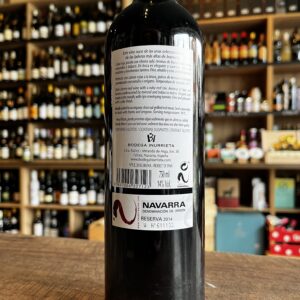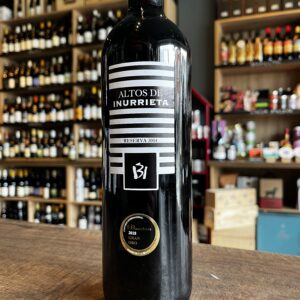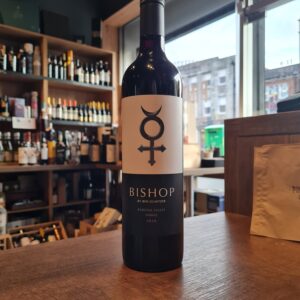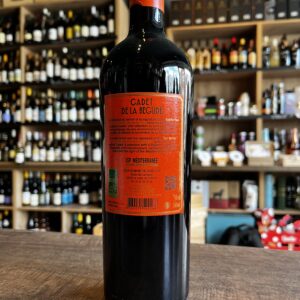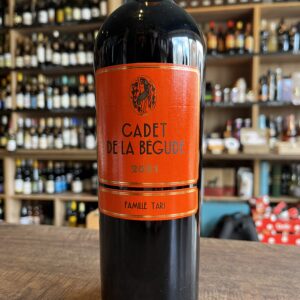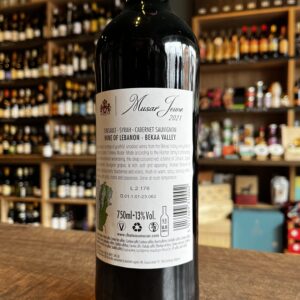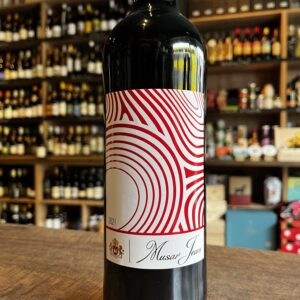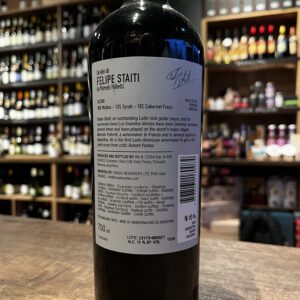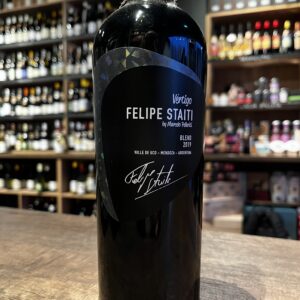Syrah, or shiraz as it’s known in the New World, is considered to be one of the great noble black grape varieties, because it can produce such deliciously dark, full-bodied and age-worthy wines.
Expect rich, brooding flavours of blackberry, black plums and blackcurrant, with spicy, coffee, leathery and liquorice notes in hotter regions and gamey, truffle notes developing with a bit of age.
-
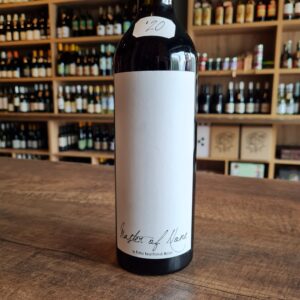 Master of none - Playing with words referring to themselves not being an expert in any one varietal or wine style hence the saying: “Jack of all trades, master of none”. Clever and humble, nonetheless, their wines are at the forefront not only of South Africa but in the world with the amazing wines they are producing. If you enjoy reds on the lighter end of the spectrum such as Pinot Noir or Gamay then Pieter's 'Master of None' will definitely be up your street! It comprises a blend of 5 different grape varieties from tiny vineyard plots across 6 distinct regions; 40% Grenache from Wellington, 30% Cinsault from sites in Darling and Stellenbosch, 8% Pinot Noir from Elgin and a further 8% Syrah from Swartland. Unusually, Pieter then tops up the blend with Voor Paardeberg Chenin Blanc, adding aromatic freshness to the finished wine. It drinks like a top-class Beaujolais – super bright and juicy, bursting with wild strawberry, cherry and with an earthy, smoky undercurrent. Enjoy at room temperature or slightly chilled – perfect for summer drinking! “In 2004, a lady came to my house to buy wine. She asked for anything but Shiraz. “I don’t drink Shiraz”, were her exact words. I poured her a glass of wine. She loved it and bought 3 cases. It was a straight Shiraz. It’s a fact – we do judge the book by its cover.”
Master of none - Playing with words referring to themselves not being an expert in any one varietal or wine style hence the saying: “Jack of all trades, master of none”. Clever and humble, nonetheless, their wines are at the forefront not only of South Africa but in the world with the amazing wines they are producing. If you enjoy reds on the lighter end of the spectrum such as Pinot Noir or Gamay then Pieter's 'Master of None' will definitely be up your street! It comprises a blend of 5 different grape varieties from tiny vineyard plots across 6 distinct regions; 40% Grenache from Wellington, 30% Cinsault from sites in Darling and Stellenbosch, 8% Pinot Noir from Elgin and a further 8% Syrah from Swartland. Unusually, Pieter then tops up the blend with Voor Paardeberg Chenin Blanc, adding aromatic freshness to the finished wine. It drinks like a top-class Beaujolais – super bright and juicy, bursting with wild strawberry, cherry and with an earthy, smoky undercurrent. Enjoy at room temperature or slightly chilled – perfect for summer drinking! “In 2004, a lady came to my house to buy wine. She asked for anything but Shiraz. “I don’t drink Shiraz”, were her exact words. I poured her a glass of wine. She loved it and bought 3 cases. It was a straight Shiraz. It’s a fact – we do judge the book by its cover.” -
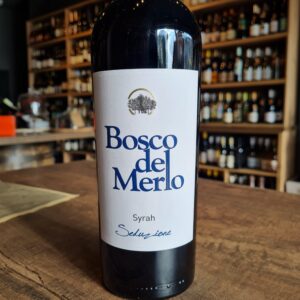 The Syrah is an international grape variety famous for its spicy notes that Bosco del Merlo interprets with great elegance. The grapes are harvest at optimally maturity during the last days of September. This Syrah ''Seduzione'' is large and round wine with great character. Enveloping and very pleasant for its harmony and wideness. Ideal for all meals, excellent with dishes of boiled and baked meats. Perfect with cold cuts and cheeses of medium maturing and insuperable alone, after dinner or in company.
The Syrah is an international grape variety famous for its spicy notes that Bosco del Merlo interprets with great elegance. The grapes are harvest at optimally maturity during the last days of September. This Syrah ''Seduzione'' is large and round wine with great character. Enveloping and very pleasant for its harmony and wideness. Ideal for all meals, excellent with dishes of boiled and baked meats. Perfect with cold cuts and cheeses of medium maturing and insuperable alone, after dinner or in company. -
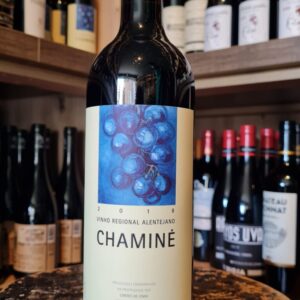 In 1988, A Danish-American couple, Hans and Carrie Jorgensen set out in a sailboat to find a place to start a family and plant vines. They came to Alentejo and they found “Cortes de Cima.” It was just a barren land and a few abandoned buildings. But Carrie, of Portuguese ancestry, said the landscape reminded her of California, her homeland. Hans, who was born in Denmark, fell in love with the Mediterranean sun. Their first wine was "born" in 1998 and the many successful vintages which followed as well as their pioneering spirit have put Cortes de Cima on the map. The main grape used is Aragonez (Spanish call it Tempranillo). It has a overt nose of fresh cherries, red plum, dark fruits and a lick of black liquorice. It is vibrant and well-rounded on the palate with good acidity and body. There is so much to love about this wine. One of my favourites enjoy!!
In 1988, A Danish-American couple, Hans and Carrie Jorgensen set out in a sailboat to find a place to start a family and plant vines. They came to Alentejo and they found “Cortes de Cima.” It was just a barren land and a few abandoned buildings. But Carrie, of Portuguese ancestry, said the landscape reminded her of California, her homeland. Hans, who was born in Denmark, fell in love with the Mediterranean sun. Their first wine was "born" in 1998 and the many successful vintages which followed as well as their pioneering spirit have put Cortes de Cima on the map. The main grape used is Aragonez (Spanish call it Tempranillo). It has a overt nose of fresh cherries, red plum, dark fruits and a lick of black liquorice. It is vibrant and well-rounded on the palate with good acidity and body. There is so much to love about this wine. One of my favourites enjoy!! -
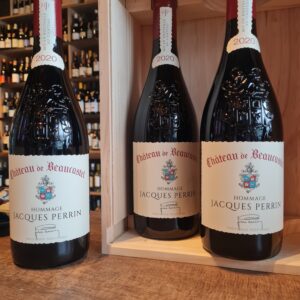 The Perrin family of Châteauneuf-du-Pape are one of the Rhône Valley’s greatest vineyard owners. With over 200 hectares of top level, prime vineyards at their fingertips, they have the terroir and skill required to produce some of the region’s finest wines. The estate traces its history back to a plot of Coudoulet vines bought by Pierre de Beaucastel in 1549. The estate was transferred into the Perrin family in 1909 through marriage, where it remains firmly to this day. Despite being one of the old guards of the region, they are also one of the most progressive estates. They were one of the first converts to organic and biodynamic faming in Châteauneuf-du-Pape, which they adopted in 1950 and 1974 respectively. A legendary Châteauneuf-du-Pape wine, Hommage à Jacques Perrin by Château de Beaucastel is one of the world's greatest wines. It brilliantly embodies the motto of the Perrin family: "A Grand Vin embodies emotion and civilisation, a legend that transcends time." The first vintage of this prestigious wine was produced in 1989. Produced in very limited quantities, the Hommage à Jacques Perrin wine comes from a unique terroir composed of rolled pebbles upon clay-limestone and silt soils in an exceptional vineyard located in the northern part of the Châteauneuf-du-Pape appellation, in the Rhône Valley. Vintage 2020 was relatively mild, the winter was punctuated by an episode of frost which had little impact on the vineyards, even the earliest plots. While the mildness of spring favoured vegetative development, a constant wind kept the soil cool. The hot, sunny summer was marked by both coolness and temperature variations between day and night, ideal conditions for ensuring a high-quality and even ripening of the grapes. Harvested at perfect maturity, the juicy and balanced grapes gave rise to a fine vintage.
The Perrin family of Châteauneuf-du-Pape are one of the Rhône Valley’s greatest vineyard owners. With over 200 hectares of top level, prime vineyards at their fingertips, they have the terroir and skill required to produce some of the region’s finest wines. The estate traces its history back to a plot of Coudoulet vines bought by Pierre de Beaucastel in 1549. The estate was transferred into the Perrin family in 1909 through marriage, where it remains firmly to this day. Despite being one of the old guards of the region, they are also one of the most progressive estates. They were one of the first converts to organic and biodynamic faming in Châteauneuf-du-Pape, which they adopted in 1950 and 1974 respectively. A legendary Châteauneuf-du-Pape wine, Hommage à Jacques Perrin by Château de Beaucastel is one of the world's greatest wines. It brilliantly embodies the motto of the Perrin family: "A Grand Vin embodies emotion and civilisation, a legend that transcends time." The first vintage of this prestigious wine was produced in 1989. Produced in very limited quantities, the Hommage à Jacques Perrin wine comes from a unique terroir composed of rolled pebbles upon clay-limestone and silt soils in an exceptional vineyard located in the northern part of the Châteauneuf-du-Pape appellation, in the Rhône Valley. Vintage 2020 was relatively mild, the winter was punctuated by an episode of frost which had little impact on the vineyards, even the earliest plots. While the mildness of spring favoured vegetative development, a constant wind kept the soil cool. The hot, sunny summer was marked by both coolness and temperature variations between day and night, ideal conditions for ensuring a high-quality and even ripening of the grapes. Harvested at perfect maturity, the juicy and balanced grapes gave rise to a fine vintage. -
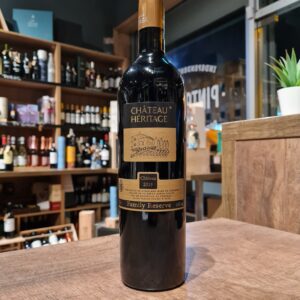 In 1888, the Touma Family established one of the first wineries and distilleries in Lebanon in the small town of Kab-elias of the Bekaa Valley (45 kilometers from Beirut) , to produce wine and Arak Touma, which is now perhaps Lebanon’s leading arak brand. Historically, the settlement goes back to the time of the Phoenicians, but the name was later changed to “Kaber Elias” (tomb of the prophet Elias), as it was believed that the prophet Elias was buried here. The Bible reports of the Prophet’s ascension to heaven in a fiery chariot at the point where John the Baptist is said to have baptized Jesus later, but the tradition of the Elijah tomb has been preserved to this day, not only among Christians, but also among the majority of the Muslim residents. During the Lebanese civil war, many Christians left Kab Elias, as they did elsewhere in Lebanon. The Touma family also had to choose to stay or leave. It was decided to stay and continue to fight and work for a presence of the Christians on the ground. In 1997, an old school building from 1932 was bought and converted into the new winery. The attempt was made to preserve the character of the original architecture in the center of Kab Elias despite all the necessary refurbishment and renovation work and alterations. Bekaa Valley is a 40-mile-long and 7-mile-wide fertile valley which is protected from rain by the Mount Lebanon mountain range to the west, and from the desert heat by the mountains on the Syrian border to the west. It lies around 1,000 metres above sea level allowing for a significant diurnal swing between the hot summer days and cool nights. The treacherous road to Beirut over the top of Mount Lebanon is frequently closed in winter due to snow. The majority of Château Héritage's vines are on the lower south-east facing slopes of Mt Lebanon, just above the winery, which ensures they're well drained with great exposure to sunlight, while being slightly cooler than the valley floor vineyards. The estate’s top wine, from their best parcels of vineyard. FOOD PAIRING: Duck, red meats, and raclette.
In 1888, the Touma Family established one of the first wineries and distilleries in Lebanon in the small town of Kab-elias of the Bekaa Valley (45 kilometers from Beirut) , to produce wine and Arak Touma, which is now perhaps Lebanon’s leading arak brand. Historically, the settlement goes back to the time of the Phoenicians, but the name was later changed to “Kaber Elias” (tomb of the prophet Elias), as it was believed that the prophet Elias was buried here. The Bible reports of the Prophet’s ascension to heaven in a fiery chariot at the point where John the Baptist is said to have baptized Jesus later, but the tradition of the Elijah tomb has been preserved to this day, not only among Christians, but also among the majority of the Muslim residents. During the Lebanese civil war, many Christians left Kab Elias, as they did elsewhere in Lebanon. The Touma family also had to choose to stay or leave. It was decided to stay and continue to fight and work for a presence of the Christians on the ground. In 1997, an old school building from 1932 was bought and converted into the new winery. The attempt was made to preserve the character of the original architecture in the center of Kab Elias despite all the necessary refurbishment and renovation work and alterations. Bekaa Valley is a 40-mile-long and 7-mile-wide fertile valley which is protected from rain by the Mount Lebanon mountain range to the west, and from the desert heat by the mountains on the Syrian border to the west. It lies around 1,000 metres above sea level allowing for a significant diurnal swing between the hot summer days and cool nights. The treacherous road to Beirut over the top of Mount Lebanon is frequently closed in winter due to snow. The majority of Château Héritage's vines are on the lower south-east facing slopes of Mt Lebanon, just above the winery, which ensures they're well drained with great exposure to sunlight, while being slightly cooler than the valley floor vineyards. The estate’s top wine, from their best parcels of vineyard. FOOD PAIRING: Duck, red meats, and raclette. -
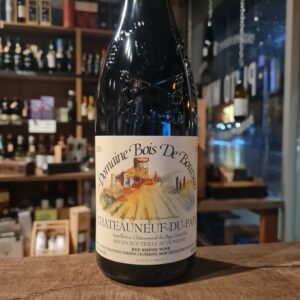 Domaine Bois de Boursan makes exemplary Châteauneuf-du-Pape in the Southern Rhône. This family-run estate was started by the Versino family in 1955, who moved across from Piedmont in Italy. It is now in the hands of Jean-Paul, the third generation at the helm. He takes great pride in continuing to make traditionally-styled reds with the belief that vinifying with stems and ageing the wine for extended periods in large oak foudres gives his wine its unique character. There is nothing flashy or opulent here, just wines with great character. In total, Jean-Paul has 10 hectares spread across 27 different parcels in Châteauneuf-du-Pape, with its changing soil types and vines up to 50 years old.
Domaine Bois de Boursan makes exemplary Châteauneuf-du-Pape in the Southern Rhône. This family-run estate was started by the Versino family in 1955, who moved across from Piedmont in Italy. It is now in the hands of Jean-Paul, the third generation at the helm. He takes great pride in continuing to make traditionally-styled reds with the belief that vinifying with stems and ageing the wine for extended periods in large oak foudres gives his wine its unique character. There is nothing flashy or opulent here, just wines with great character. In total, Jean-Paul has 10 hectares spread across 27 different parcels in Châteauneuf-du-Pape, with its changing soil types and vines up to 50 years old. -
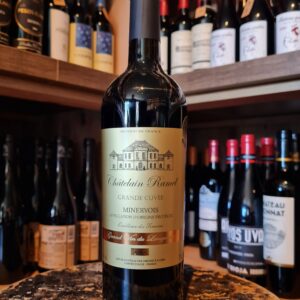 Dominated by Carignan, this is a Minervois which will wow the senses and really impress with its value for money. The fruit for the Ramel Grand Cuvee were sourced from the Domaine de la Baquiere Estate, within the heart of the Languedoc Wine Region. From 23 hectares of vineyard on the slopes of the Montagne Noire where the Ramel-Mazard family winemaking dates back to 1726, forming traditional methods of production, with the fruit harvested by hand and each grape variety vinified separately in stainless steel. This is a medium/full bodied with bright ruby edge. Interesting and attractive nose, sweet blackberry, plum notes with a smoky, meaty complexion. Cherry notes too. Medium weight palate with sweet blackberry fruit, mocha and cherry tones. Tannins are grippy but well balanced and the 14% alcohol well integrated. Would suit Duck very well, or slow cooked meats stew style dishes.
Dominated by Carignan, this is a Minervois which will wow the senses and really impress with its value for money. The fruit for the Ramel Grand Cuvee were sourced from the Domaine de la Baquiere Estate, within the heart of the Languedoc Wine Region. From 23 hectares of vineyard on the slopes of the Montagne Noire where the Ramel-Mazard family winemaking dates back to 1726, forming traditional methods of production, with the fruit harvested by hand and each grape variety vinified separately in stainless steel. This is a medium/full bodied with bright ruby edge. Interesting and attractive nose, sweet blackberry, plum notes with a smoky, meaty complexion. Cherry notes too. Medium weight palate with sweet blackberry fruit, mocha and cherry tones. Tannins are grippy but well balanced and the 14% alcohol well integrated. Would suit Duck very well, or slow cooked meats stew style dishes. -
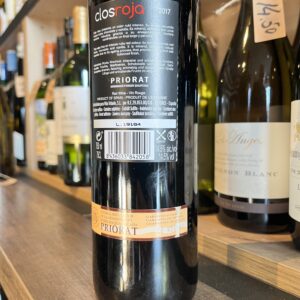
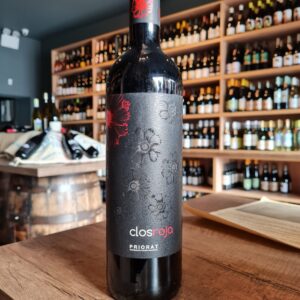 This is one of our favourite wine-finds of late! Priorat, a wine region in northeastern Spain, is known for stunning, terraced vineyards and robust red blends that often fetch a pretty penny. An old vine blend of Grenache, Carignan, Syrah, Cabernet and Merlot finished in French and American oak barrels. Notes of red cherry, chocolate define this silky & balanced wine! Lovely with Red meats, blue cheese or Chocolate.
This is one of our favourite wine-finds of late! Priorat, a wine region in northeastern Spain, is known for stunning, terraced vineyards and robust red blends that often fetch a pretty penny. An old vine blend of Grenache, Carignan, Syrah, Cabernet and Merlot finished in French and American oak barrels. Notes of red cherry, chocolate define this silky & balanced wine! Lovely with Red meats, blue cheese or Chocolate. -
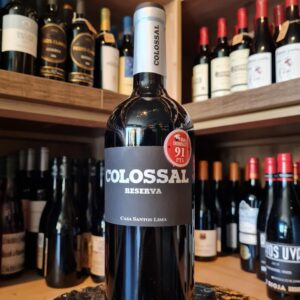 This blend of Touriga Nacional, Syrah, Tinta Roriz, and Alicante Bouschet lives up to its name. With an intense rubi colour, this wine presents itself with a great concentration in the nose. Extremely rich aroma with predominance of red ripe fruits and some floral notes, well integrated with notes of spices coming from the ageing in French and American oak barrels. In the mouth it shows great complexity with notes of plums and blackberries. The finish is rich and elegant. Excellent wine for hearty spiced meals with red grilled or roast meat, lamb and game dishes. Enjoy!
This blend of Touriga Nacional, Syrah, Tinta Roriz, and Alicante Bouschet lives up to its name. With an intense rubi colour, this wine presents itself with a great concentration in the nose. Extremely rich aroma with predominance of red ripe fruits and some floral notes, well integrated with notes of spices coming from the ageing in French and American oak barrels. In the mouth it shows great complexity with notes of plums and blackberries. The finish is rich and elegant. Excellent wine for hearty spiced meals with red grilled or roast meat, lamb and game dishes. Enjoy! -
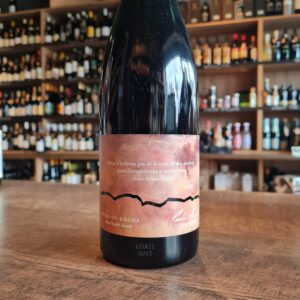 Vincent Rochette comes from a long line of grape growers rather than winemakers. In 1998, he bucked that trend by investing in a cellar and the necessary equipment to allow him to vinify his own grapes, which for five generations had been sold to other winemakers in the area. Vincent is an ardent believer in the benefits of biodynamics, fully converting his estate to follow that philosophy in 2006. He uses only natural products in the vineyard and carries out all his work in keeping with the cosmic cycles of the earth, not only among the vines but also in the cellar. One of his most interesting cuvées is the Côte du Rhone ‘Nature’, which has had no sulphites added at any stage of the winemaking process. Due to the fact that sulphites are naturally present in grapes, there are still 9mg present (below the legal 10mg limit which is required to state that the wine contains sulphites). The result is a wine that is simply a pure expression of Grenache and Syrah. Harvesting, racking and bottling are all carried out in accordance with cosmic rhythms. A delicious wine to consume today, with grills, summer salads, spicy dishes such as couscous, a tagine with candied fruits (apricots, lemons, onions, etc.)
Vincent Rochette comes from a long line of grape growers rather than winemakers. In 1998, he bucked that trend by investing in a cellar and the necessary equipment to allow him to vinify his own grapes, which for five generations had been sold to other winemakers in the area. Vincent is an ardent believer in the benefits of biodynamics, fully converting his estate to follow that philosophy in 2006. He uses only natural products in the vineyard and carries out all his work in keeping with the cosmic cycles of the earth, not only among the vines but also in the cellar. One of his most interesting cuvées is the Côte du Rhone ‘Nature’, which has had no sulphites added at any stage of the winemaking process. Due to the fact that sulphites are naturally present in grapes, there are still 9mg present (below the legal 10mg limit which is required to state that the wine contains sulphites). The result is a wine that is simply a pure expression of Grenache and Syrah. Harvesting, racking and bottling are all carried out in accordance with cosmic rhythms. A delicious wine to consume today, with grills, summer salads, spicy dishes such as couscous, a tagine with candied fruits (apricots, lemons, onions, etc.) -
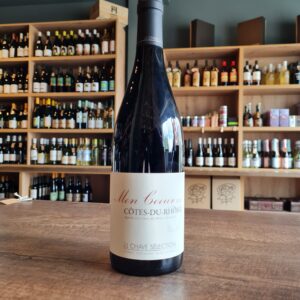 Domaine Jean-Louis Chave is one of the finest producers in the Northern Rhone. 16 generations of wine making has led to mastery of their art. This astonishing experience and expertise is pervasive in this wine. This deliciously ripe Syrah/Grenache blend has a wonderful core of dark, berry fruit supported by a framework of ripe tannin with cooling, granitic notes and a sleek, sophisticated texture. The sublime quality of the wines at this Domaine have meant that there has always been a long queue of Wine Merchants desperate for a glimpse of the Chave cellars. Gerard's son, Jean-Louis makes the wine at the Estate now and his ideal is to produce wine that is as pure an expression of the grape and terroir as possible. He achieves this by only vinifying the healthiest grapes produced from low yielding vines, intervening as little as possible while making the wine and bottling without filtration. His wines are some of the Rhône’s most complete and sophisticated examples. Jean Louis Chaves' selection wines are benchmarks of the Rhone, packed with regional character, that are made from a mixture of declassified Domaine fruit and grapes that are grown by Jean-Louis in conjunction with other vignobles. After tasting this gorgeous wine, I understood the name "Mon Coeur".
Domaine Jean-Louis Chave is one of the finest producers in the Northern Rhone. 16 generations of wine making has led to mastery of their art. This astonishing experience and expertise is pervasive in this wine. This deliciously ripe Syrah/Grenache blend has a wonderful core of dark, berry fruit supported by a framework of ripe tannin with cooling, granitic notes and a sleek, sophisticated texture. The sublime quality of the wines at this Domaine have meant that there has always been a long queue of Wine Merchants desperate for a glimpse of the Chave cellars. Gerard's son, Jean-Louis makes the wine at the Estate now and his ideal is to produce wine that is as pure an expression of the grape and terroir as possible. He achieves this by only vinifying the healthiest grapes produced from low yielding vines, intervening as little as possible while making the wine and bottling without filtration. His wines are some of the Rhône’s most complete and sophisticated examples. Jean Louis Chaves' selection wines are benchmarks of the Rhone, packed with regional character, that are made from a mixture of declassified Domaine fruit and grapes that are grown by Jean-Louis in conjunction with other vignobles. After tasting this gorgeous wine, I understood the name "Mon Coeur". -
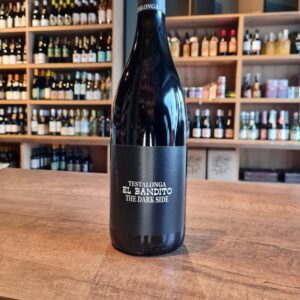 The El Bandito The Dark Side 2017 by Testalonga comes from Shiraz vineyards from the early 2000s - the vines are still in full bloom, but thanks to the low yield, they are already delivering phenolic grapes. The vineyards are cultivated by Craig with no herbicites, pesticides or fungicites. He also does without artificial irrigation. These measures alone have a positive effect on the quality of the grapes and keep the yield low. After hand-picking, the grapes are fermented spontaneously with the vineyard's own yeast and matured in 3000l wooden barrels. After expansion, it is neither fined nor filtered and filled with minimal sulfur. The Testalonga El Bandito The Dark Side has a deep dark color with a black core. It smells of red berries and dark stone fruits, of cloves, mocha and cocoa beans as well as tart spiciness. On the palate it has a present tannin and a fine interplay of acids. In terms of alcohol, the Shiraz is quite slim and straight, but still brings a weighty body into play. The finish is long and dominated by the heavier aromas. The El Bandito The Dark Side Shiraz demands air, so give it a few hours in the carafe before serving it slightly chilled from large glasses with roasted game, braised lamb or an oven-baked bean stew with roasted butter crumbs and thyme.
The El Bandito The Dark Side 2017 by Testalonga comes from Shiraz vineyards from the early 2000s - the vines are still in full bloom, but thanks to the low yield, they are already delivering phenolic grapes. The vineyards are cultivated by Craig with no herbicites, pesticides or fungicites. He also does without artificial irrigation. These measures alone have a positive effect on the quality of the grapes and keep the yield low. After hand-picking, the grapes are fermented spontaneously with the vineyard's own yeast and matured in 3000l wooden barrels. After expansion, it is neither fined nor filtered and filled with minimal sulfur. The Testalonga El Bandito The Dark Side has a deep dark color with a black core. It smells of red berries and dark stone fruits, of cloves, mocha and cocoa beans as well as tart spiciness. On the palate it has a present tannin and a fine interplay of acids. In terms of alcohol, the Shiraz is quite slim and straight, but still brings a weighty body into play. The finish is long and dominated by the heavier aromas. The El Bandito The Dark Side Shiraz demands air, so give it a few hours in the carafe before serving it slightly chilled from large glasses with roasted game, braised lamb or an oven-baked bean stew with roasted butter crumbs and thyme. -
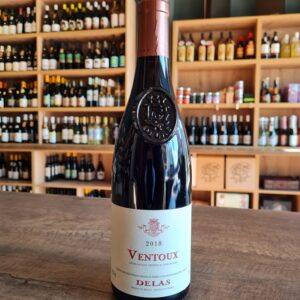 Delas Frères Ventoux is a red wine blend made with grapes from the south eastern region of the Rhône winegrowing region of France. Delas Frères are one of the most prestigious Rhone wine producers and make superb wines, from a wide selection of appellations, in both the northern and southern Rhône including Hermitage, Crozes-Hermitage, Châteauneuf-du-Pape, Côte Rôtie, Condrieu and Côtes-du-Rhône. The company was founded in 1835 when Charles Audibert and Philippe Delas bought Maisons Junique, a 40-year-old winery which they renamed Audibert & Delas. Philippe Delas had two sons, Henri and Florentin. The latter married the daughter of Charles Audibert, further strengthening the bond between the two families. In 1924, the brothers succeeded to the founders and changed the name of the house to Delas Frères. The company grew and in 1981 relocated to the its current premises in Saint Jean de Muzols, a small village located two kilometers north of Tournon in the Saint Joseph appellation. In 1993 Delas Frères became part of the Champagne Louis Roederer group. Delas Frères Ventoux is a blend of Grenache and Syrah grapes which are sourced from the communes of Mazan and Goult from vineyards which stretch out along the left bank of the Rhône river, around the limestone outcrop of the Mount Ventoux. The Grenache grapes are fermented in stainless steel vats with a daily pumping over to allow gentle extraction of the phenolic components. The Syrah is sometimes left on the stems in order to fully express its characteristic fruit aromas. The two components are blended before they wines is matured for 6 to 8 months in Delas’ air-conditioned winery before bottling.
Delas Frères Ventoux is a red wine blend made with grapes from the south eastern region of the Rhône winegrowing region of France. Delas Frères are one of the most prestigious Rhone wine producers and make superb wines, from a wide selection of appellations, in both the northern and southern Rhône including Hermitage, Crozes-Hermitage, Châteauneuf-du-Pape, Côte Rôtie, Condrieu and Côtes-du-Rhône. The company was founded in 1835 when Charles Audibert and Philippe Delas bought Maisons Junique, a 40-year-old winery which they renamed Audibert & Delas. Philippe Delas had two sons, Henri and Florentin. The latter married the daughter of Charles Audibert, further strengthening the bond between the two families. In 1924, the brothers succeeded to the founders and changed the name of the house to Delas Frères. The company grew and in 1981 relocated to the its current premises in Saint Jean de Muzols, a small village located two kilometers north of Tournon in the Saint Joseph appellation. In 1993 Delas Frères became part of the Champagne Louis Roederer group. Delas Frères Ventoux is a blend of Grenache and Syrah grapes which are sourced from the communes of Mazan and Goult from vineyards which stretch out along the left bank of the Rhône river, around the limestone outcrop of the Mount Ventoux. The Grenache grapes are fermented in stainless steel vats with a daily pumping over to allow gentle extraction of the phenolic components. The Syrah is sometimes left on the stems in order to fully express its characteristic fruit aromas. The two components are blended before they wines is matured for 6 to 8 months in Delas’ air-conditioned winery before bottling. -
Out of stock
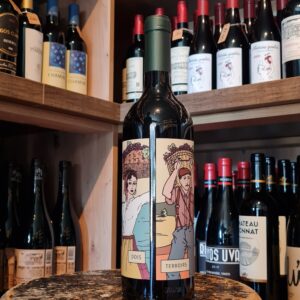 This blend of Aragonez, Syrah and Pinot Noir results from the fusion of two distinct terroirs, where the Mediterrean climate of the Alentejan interior meets the cool maritime climate of the Alentejan Atlantic coast. Pinot Noir, grown in sandy soils in our cool, Alentejan Atlantic coastal vineyards, provides freshness and elegance to balance the fruit generosity of the Aragonez and Syrah grown further inland, on the ancient clay over limestone soils surrounding the Estate. Viticulture here is certified sustainable. Attractive lifted red berry fruit aromas, with a touch of vanilla. Vibrant fruit on the palate, juicy and intense, finishing with a nice acidity.
This blend of Aragonez, Syrah and Pinot Noir results from the fusion of two distinct terroirs, where the Mediterrean climate of the Alentejan interior meets the cool maritime climate of the Alentejan Atlantic coast. Pinot Noir, grown in sandy soils in our cool, Alentejan Atlantic coastal vineyards, provides freshness and elegance to balance the fruit generosity of the Aragonez and Syrah grown further inland, on the ancient clay over limestone soils surrounding the Estate. Viticulture here is certified sustainable. Attractive lifted red berry fruit aromas, with a touch of vanilla. Vibrant fruit on the palate, juicy and intense, finishing with a nice acidity. -
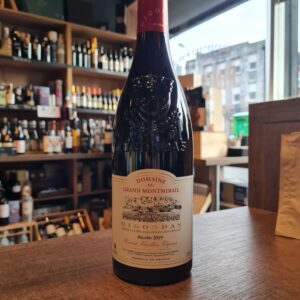 Domaine du Grand Montmirail Gigondas lies in the foothills of a limestone escarpment in a remote part of Gigondas. A blend of Grenache, Syrah and Mourvedre, this wine has real depth of flavour with concentrated black fruits balanced by fresh acidity and a rich warm finish. In Gigondas, cultivating grapes to make wine and olives to make oil stretches back to ancient times. As long ago as the 1st century, Julius Caesar established a colony of veterans on this site. One is said to have been so jovial that he was nicknamed Jucundus, 'the joyful', and his village became known as Jocundatis, which later became Gigondas. Domain du Grand Montmirail covers more than 35 Ha, planted exclusively on the hillsides and terraces located south / south-east side of the Dentelles de Montmirail, forming a superb amphitheater dedicated to the vine and the wine. The altitude of the vineyard varies between 300 and 350 meters and enjoys natural protection against the wind dominating the mistral. The vineyard is composed of Grenache, Syrah and Mourvèdre parcels, aged between 15 and 65 years. The harvest begins with Syrah, the quickest grape to ripen, and then the Grenache in the highest spots. The Mourvèdre is the slowest ripening and usually the last grape to be harvested. The entire harvest is picked by hand, and yields are never more than 35 hl/ha. Among the old vines on the terraces, they generally fall to a maximum of 30 hl/ha. The recently picked grapes are transported quickly to the winery situated off to the side of the vineyards. Pair it with Beef, Casserole, Lamb, Mushrooms
Domaine du Grand Montmirail Gigondas lies in the foothills of a limestone escarpment in a remote part of Gigondas. A blend of Grenache, Syrah and Mourvedre, this wine has real depth of flavour with concentrated black fruits balanced by fresh acidity and a rich warm finish. In Gigondas, cultivating grapes to make wine and olives to make oil stretches back to ancient times. As long ago as the 1st century, Julius Caesar established a colony of veterans on this site. One is said to have been so jovial that he was nicknamed Jucundus, 'the joyful', and his village became known as Jocundatis, which later became Gigondas. Domain du Grand Montmirail covers more than 35 Ha, planted exclusively on the hillsides and terraces located south / south-east side of the Dentelles de Montmirail, forming a superb amphitheater dedicated to the vine and the wine. The altitude of the vineyard varies between 300 and 350 meters and enjoys natural protection against the wind dominating the mistral. The vineyard is composed of Grenache, Syrah and Mourvèdre parcels, aged between 15 and 65 years. The harvest begins with Syrah, the quickest grape to ripen, and then the Grenache in the highest spots. The Mourvèdre is the slowest ripening and usually the last grape to be harvested. The entire harvest is picked by hand, and yields are never more than 35 hl/ha. Among the old vines on the terraces, they generally fall to a maximum of 30 hl/ha. The recently picked grapes are transported quickly to the winery situated off to the side of the vineyards. Pair it with Beef, Casserole, Lamb, Mushrooms -
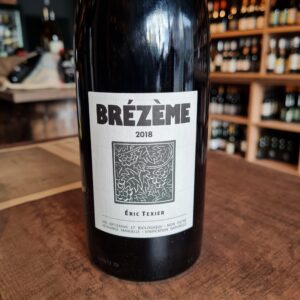 The 2019 Cotes du Rhone Brézème is a big, well structured wine that retains the freshness and lively character always present in this cuvee. The wine was vinified naturally, without added sulfur. The wine shows vivid aromas of blackberry and black cherry with hints of musk, blueberry, earth and citrus. The palate is deep and textured with earthy black fruits, bitter chocolate and mineral flavours, quite pure and long. Serve now, slightly chilled, with grilled meats, tagines and full-flavored cheeses, or cellar fo five to ten years or more.
The 2019 Cotes du Rhone Brézème is a big, well structured wine that retains the freshness and lively character always present in this cuvee. The wine was vinified naturally, without added sulfur. The wine shows vivid aromas of blackberry and black cherry with hints of musk, blueberry, earth and citrus. The palate is deep and textured with earthy black fruits, bitter chocolate and mineral flavours, quite pure and long. Serve now, slightly chilled, with grilled meats, tagines and full-flavored cheeses, or cellar fo five to ten years or more. -
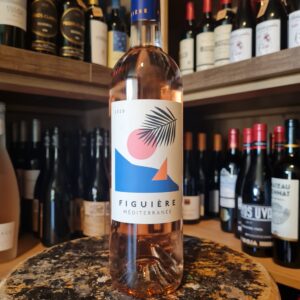 Here is a Provençal estate rosé sure to add some style to your summer! One smell, one sip and you get beamed to the Mediterranean Sea! This delicious Rosé is created by a pioneering Provence domaine of excellence. The family Combard is one of the ambassadors of a new generation of prestigious winemakers. You can smell notes of white flowers that then develop into white peach aromas. The palate expresses the velvety texture of citrus peel and the zestiness of an essential oil. Citrus profile with this wine that is astringent, green, tight and fresh.
Here is a Provençal estate rosé sure to add some style to your summer! One smell, one sip and you get beamed to the Mediterranean Sea! This delicious Rosé is created by a pioneering Provence domaine of excellence. The family Combard is one of the ambassadors of a new generation of prestigious winemakers. You can smell notes of white flowers that then develop into white peach aromas. The palate expresses the velvety texture of citrus peel and the zestiness of an essential oil. Citrus profile with this wine that is astringent, green, tight and fresh. -
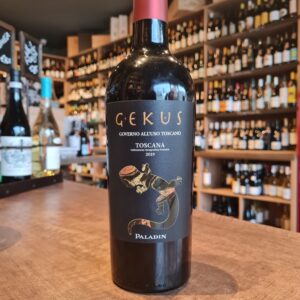 There are many ways in which to fall in love with Tuscany, not the least of which is through the region’s wonderful wines—or its landscape, its people, its food, and its art. Paladin's example of Super Tuscan wines comes in this form. A local take on the classic Bordeaux-style blend of Cabernet Sauvignon, Merlot, and Syrah (and sometimes Cabernet Franc), these wines were developed, in part, as a reaction to the restrictive regulations in Tuscany during the 1970s. At the time they emerged, they were considered some of the region’s best reds. Yet, somewhat ironically, they were technically table wine. In 1994, their Vino da Tavola (VdT) status was elevated to the Indicazione Geografica Tipica (IGT) denomination, which officially endowed these non-traditional wines with a premium quality rating just below the Denominazione di Origine Controllata (DOC), which at that time was reserved for more traditional regional wines. The tonneau used at Paladin hold 2 to 3,000 litters. Very impressive if you compare the barrels with a normal barrique barrel. Even though Gekus is only aged for 3 months, the body that it has is quite pronounced and it is indicative of the extraction done with the grapes. The bottle itself already shows through its weight that we are about to encounter something phenomenal, something heavy, something Super. The palate is complex and you can feel the residual sugar without it being sweet to a point of being unpleasant. Recommended with red meat, it is traditionally very popular with pici (thick spaghetti) with meat sauce. Serve at room temperature.
There are many ways in which to fall in love with Tuscany, not the least of which is through the region’s wonderful wines—or its landscape, its people, its food, and its art. Paladin's example of Super Tuscan wines comes in this form. A local take on the classic Bordeaux-style blend of Cabernet Sauvignon, Merlot, and Syrah (and sometimes Cabernet Franc), these wines were developed, in part, as a reaction to the restrictive regulations in Tuscany during the 1970s. At the time they emerged, they were considered some of the region’s best reds. Yet, somewhat ironically, they were technically table wine. In 1994, their Vino da Tavola (VdT) status was elevated to the Indicazione Geografica Tipica (IGT) denomination, which officially endowed these non-traditional wines with a premium quality rating just below the Denominazione di Origine Controllata (DOC), which at that time was reserved for more traditional regional wines. The tonneau used at Paladin hold 2 to 3,000 litters. Very impressive if you compare the barrels with a normal barrique barrel. Even though Gekus is only aged for 3 months, the body that it has is quite pronounced and it is indicative of the extraction done with the grapes. The bottle itself already shows through its weight that we are about to encounter something phenomenal, something heavy, something Super. The palate is complex and you can feel the residual sugar without it being sweet to a point of being unpleasant. Recommended with red meat, it is traditionally very popular with pici (thick spaghetti) with meat sauce. Serve at room temperature. -
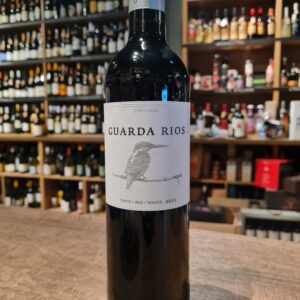 The first Guarda Rios harvest was done in 2006 and, curiously, not in the Alentejo. This wine is associated to the Winemaker and Director of Monte da Ravasqueira, who, in 2012, brought the Guarda Rios with him. Like the birds, this wine migrated and settled next to the dams on a property in Arraiolois, where it found the ideal terroir in which to express all its exuberance and vivacity. The family currently owns 45 hectares under vine in the Alentejo Plains. The highlight of this vineyard is that there are close to 8 diverse soil types and 29 carefully selected plots here. Therefore, it is great for growing quite a few full-bodied grape varietals. The vines are grown at an average height of about 270m above sea level. The Alentejo Plains cover almost one-third of Portugal, and are home to various soil types such as clay, sandy, marble, granite, limestone, shale and more. Thanks to the hot & dry Mediterranean climate in this area, it is ideal for growing some of the rare & indigenous varietals. The native reds grown here are Aragonez, Trincadeira and Alicante Bouschet. Roupeiro, Arinto and Antao Vaz are the native whites grown here. All of these are grown in organized regions along Alentejo. The main regions of the plains where the vines are grown with utmost care & dedication are Borba, Redondo, Reguengos and Evora. These regions are divided based on their climate, soil quality and their ability to create full-bodied & aromatic grapes.
The first Guarda Rios harvest was done in 2006 and, curiously, not in the Alentejo. This wine is associated to the Winemaker and Director of Monte da Ravasqueira, who, in 2012, brought the Guarda Rios with him. Like the birds, this wine migrated and settled next to the dams on a property in Arraiolois, where it found the ideal terroir in which to express all its exuberance and vivacity. The family currently owns 45 hectares under vine in the Alentejo Plains. The highlight of this vineyard is that there are close to 8 diverse soil types and 29 carefully selected plots here. Therefore, it is great for growing quite a few full-bodied grape varietals. The vines are grown at an average height of about 270m above sea level. The Alentejo Plains cover almost one-third of Portugal, and are home to various soil types such as clay, sandy, marble, granite, limestone, shale and more. Thanks to the hot & dry Mediterranean climate in this area, it is ideal for growing some of the rare & indigenous varietals. The native reds grown here are Aragonez, Trincadeira and Alicante Bouschet. Roupeiro, Arinto and Antao Vaz are the native whites grown here. All of these are grown in organized regions along Alentejo. The main regions of the plains where the vines are grown with utmost care & dedication are Borba, Redondo, Reguengos and Evora. These regions are divided based on their climate, soil quality and their ability to create full-bodied & aromatic grapes.


